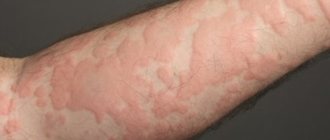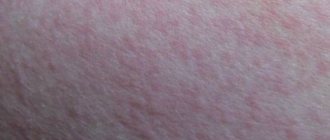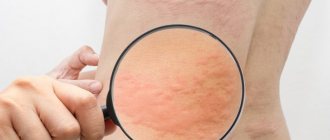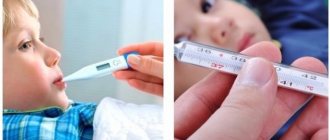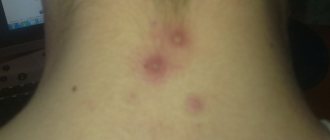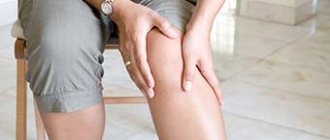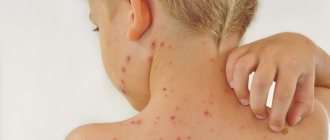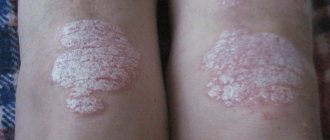In this article we will talk about a type of disease called urticaria on the legs. There are many irritating ailments, usually all of them are allergic in nature. One of these is an allergic rash, or in other words, urticaria. The name of this disease originated among the people.
Hives occur in both children and adults and can appear on any part of the body. In this article we will talk about a type of disease called urticaria on the legs. There it appears most often and is most unpleasantly tolerated. So how can you treat hives or avoid them if possible?
Symptoms and manifestations of urticaria on the legs
The name “Hives” comes from the appearance of spots that appear on the skin and look like burns from the herbaceous plant “nettle”. Urticaria is not easy to identify; its symptoms are similar to other skin diseases.
The main symptoms of urticaria:
- redness on the legs;
- rash in the form of small red spots;
- small blisters;
- itching;
- temperature increase.
Symptoms of severe disease:
- muscle pain;
- chills;
- labored breathing;
- arrhythmia;
- dizziness.
How it develops
Urticaria can progress through immune and non-immune mechanisms. Thus, allergic manifestations develop in 4 main types:
- I. The initial entry of irritants - allergens into the body causes the formation of specific antibodies (immune cells). In this regard, upon repeated contact with the pathogen, patients are faced with the following symptoms of urticaria on the thighs, hyperemia, itching, swelling, and the appearance of a characteristic rash - red-pink blisters of different sizes with clear outlines. This type of allergic reaction develops at lightning speed - from a few seconds to 5-10 minutes from the moment the irritant enters the body.
- II, III. These mechanisms of progression of urticaria are much less common than the previous type and accompany the chronic course of the disease.
- IV. Non-immune pathway for the development of an allergic reaction. External factors and certain medications (Aspirin, Indomethacin) do not indirectly, but directly affect mast cells, causing the release of active substances that provoke skin manifestations (for example, histamine).
Urticaria on the legs: causes
The main reasons that lead to the appearance of a rash on the legs:
- Allergic reaction to food.
- citrus;
- nuts;
- chocolate;
- fruits and vegetables are bright red;
- food colors and additives.
- Allergy to medications. vitamin complexes;
- antibiotics;
- anti-inflammatory medications;
- analgesics, antispasmodics.
- foot creams;
- fluff;
Prevention
Prevention of hives is important. Preventive actions:
- hypoallergenic diet;
- avoiding contact with a possible allergen;
- taking antihistamines for seasonal allergies in the spring;
- healthy lifestyle;
- avoiding stress;
- choosing clothes only from natural fabrics;
- use of hypoallergenic cosmetics for foot care;
- maintaining optimal climatic conditions in the house - air temperature no higher than 24 ˚C;
- regular wet cleaning.
Urticaria on the toes often occurs due to improperly sized or poor-quality shoes, excessive sweating and fungal diseases. That is why you should give preference to comfortable leather shoes and socks made from natural materials. It is necessary to cure fungal infections and maintain foot hygiene.
Treatment for hives should begin as soon as the blisters appear. There is no point in waiting for the disease to go away on its own. It is necessary to find out the cause of the allergy on the legs and eliminate it once and for all, so that a chronic form does not occur.
Contact your doctor. Diagnostics
To make a correct diagnosis, you need to conduct a thorough examination by an allergist, immunologist, dermatologist and neurologist.
The examination proceeds as follows:
- Taking a general blood test with a formula. If the number of eosinophils in the blood increases, there is an allergy.
- Passing an immunological test.
- Determination of skin tests for allergens.
- Detection of helminths. The presence of parasites is one of the causes of urticaria.
If urticaria does not go away for more than 45 days or appears again at certain intervals, it is a chronic form of the disease. A disease that manifests itself abruptly to an irritant and lasts no more than two weeks is an acute form of urticaria.
Preventive measures and possible complications
Specialists, based on the results of tests and examinations, prescribe preventive measures that will be individual for everyone.
As a rule, the list of preventive actions includes:
- Restore the correct diet and add more dairy products, cheese, sour cream and kefir (if there are no allergic reactions or other contraindications).
- Lead an active lifestyle and engage in physical exercises that help restore the balance of proper metabolism.
- Use of hormonal, antihistamines and antibiotics (as prescribed by specialists).
Prevention is prescribed depending on whether there are any allergic reactions that can aggravate the health condition and provoke further development of the disease. Medicines and antibiotics are prescribed by a specialist, and it is also necessary to visit an allergist, who will conduct an examination and determine whether there are any contraindications to any medications.
Treatment of such an ailment and symptoms is possible; for this you need to contact specialists who will conduct an examination and prescribe special treatment methods for everyone. Basically, dermatologists prescribe the following treatment:
- The use of antihistamines (mainly loratadine, diphenhydramine, ebastine, suprastin, acrivastine and pipolfen).
- Injections and injections that are necessary to destroy viruses and bacteria of the disease (if the drugs do not help).
- If it is an allergic type, then medications are prescribed against allergies to any substances.
- It is recommended to exclude certain foods from your diet (sweets, alcoholic drinks and other unhealthy foods).
Such treatment methods are used to relieve inflammation of the skin and discomfort. Hives and rashes are dangerous because they completely disrupt the normal condition of the skin, and at the same time the processes of thermoregulation and metabolism are disrupted. In such cases, experts do not recommend undertaking treatment on their own, especially prescribing medications and dosages that can negatively affect health and affect circulatory processes, in which the level of leukocytes in the blood doubles.
Prevention includes avoiding contact with allergens and creating a hypoallergenic environment. It is necessary to ventilate the room, humidify the air, replace feather pillows and duvets with padding polyester, use hypoallergenic products when washing, avoid contact with animals, eat right, and do not breed plants with pollen.
One of the dangerous complications is anaphylactic shock, which can be fatal. If fever is not detected in time, it develops into chronic.
Treatment
Relief from itching. To relieve the severe itching that accompanies the disease, you need to use ointments, gels, and antihistamine creams.
A 1% menthol solution (alcohol) will not eliminate the cause of the disease, but will relieve itching.
A folk remedy will help get rid of the desire to scratch reddened areas: dilute 2 tbsp. l. lemon juice in 4 tbsp. l. water. Wipe the damaged areas of the skin of the legs with this solution.
Basic Rules
To get rid of hives quickly and without consequences, you need to follow the rules:
- identify the allergen to which the reaction occurred. Eliminate it from use;
- stop taking medications to which you are allergic;
- free the skin from contact with pressing parts of clothing, allow the feet to “breathe”, wear spacious shoes;
- put on your feet only things made from natural fabrics;
- wash your feet only with mild soap that does not contain fragrances or dyes;
- wrap the limbs with a rag soaked in cold water (cannot be used if you have a cold allergy);
- ventilate the room, do not overheat the room;
- follow a diet;
- calm down, watch a nice movie, listen to your favorite music.
Medication method
It is impossible to do without the use of medications in the treatment of urticaria on the legs. When taking medications, your legs will itch less, swelling and redness will subside.
Systemic treatment should be prescribed by a doctor who will select a specific drug and this will lead to rapid relief of the main symptoms of the disease. We will consider what means are available below.
Why does a rash appear in adults?
If with allergic reactions everything is quite simple and clear, then the diseases can be different. Let's try to figure out the entire list of diseases that cause or can cause rashes on the legs, find out how it manifests itself and what should be done in each specific case.
Chicken pox
Also called chickenpox, it is an infectious disease caused by the herpes virus.
It is transmitted by airborne droplets through mucous membranes, and this happens quite simply and quickly.
The peculiarity of this disease is that it is almost impossible to get it a second time.
The vast majority of people develop immunity, which is why children under 2 years of age often suffer from this disease.
The main symptom of chickenpox is a rash that is very characteristic.
Let's see how it all happens:
- A papule (nodule) appears;
- Then it quickly turns into a vesicle (bubble);
- After a few days, the bubble bursts and begins to dry out;
- After drying, a crust forms in place of the papule;
- After opening the crust, scars almost never remain.
During chickenpox, the rash is observed throughout the body, so if you notice strange rashes on the legs, you should examine the whole body.
Rubella
A viral disease transmitted by airborne droplets. Without specific immunity, the degree of contact exceeds 90%. Rubella is mainly a childhood disease; adults rarely get it.
Let's look at the main symptoms of the disease:
- Temperature increase;
- All symptoms of colds appear;
- Conjunctivitis;
- Loss of appetite;
- Headache;
- Malaise;
- Swollen joints;
- The rash is bright red. Initially they are pinkish, and then begin to take on a brighter color;
- In children these are small spots, in adults they are quite large;
- Most often, the rash begins in the ear area and then spreads throughout the body to the legs. However, sometimes spots may begin to appear on the legs.
In a word, Rubella is very similar to a serious flu, only with rashes all over the body, which usually go away in 6-7 days.
Another childhood disease, having had it, a person develops strong immunity for life. You can also get vaccinated, but its validity period is no more than 15 years.
This disease is transmitted by airborne droplets, but it is quite difficult to get sick without direct contact with a patient, since the virus does not live for a long time in an open environment.
Let's look at the list of main symptoms; they are typical for both children and adults:
- Lethargy. A person constantly wants to sleep, becomes lazy, loses interest in everything;
- A cough appears;
- The temperature rises;
- After a few days, the temperature disappears, but the cough intensifies and a runny nose appears;
- On days 4-6, the temperature rises sharply to 39 degrees and characteristic red rashes begin to appear;
- The disease is often accompanied by diarrhea and severe headache.
Treatment of the disease usually takes a little over a week. By about the 7th day, the cough and runny nose almost completely disappear, the temperature normalizes, and the rashes dry out and peel off. There are usually no traces left.
Scarlet fever
The disease is transmitted by airborne droplets. Mostly children are affected.
List of main symptoms:
- A sharp increase in body temperature up to 39 degrees;
- General malaise, weakness, headache;
- The rash is often on the upper body;
- Tachycardia;
- Increased excitability, which may alternate with apathy;
- Sore throat, sometimes a sore throat may occur;
- The tongue becomes covered with a white or grayish coating;
- Enlarged cervical lymph nodes;
- The throat becomes red (more than with a sore throat);
- A severe rash appears on the feet and palms.
Adults usually tolerate this disease more easily than children. But on the other hand, it is very important to start treatment on time, because there can be quite serious complications. With timely treatment to the hospital and proper treatment, the disease begins to subside within 6-8 days.
This disease is one of the most serious among all viral diseases. It is extremely rare; not every doctor has encountered this disease.
Adults often carry the bacteria, but their immune systems often successfully fight the virus. Children or teenagers usually get sick.
The main symptoms are as follows:
- The first and most obvious symptom is a rash all over the body;
- Temperature increase;
- Severe chills;
- Constant fatigue;
- Vomit.
Most often, all the symptoms appear very quickly, and the disease develops just as quickly.
It is very important to start treatment quickly, because otherwise, very serious consequences may occur, for example: pulmonary edema, renal failure, paralysis, epilepsy, toxic-infectious shock and others.
This disease can be transmitted by airborne droplets or fecal-oral transmission if personal hygiene is not observed. Most often, the disease affects children; it is rare in adults and sometimes goes away almost unnoticed.
The cause of infection is dirty hands or contact with a carrier.
Main symptoms:
- Runny nose, sore throat, cough;
- Temperature increase;
- Nausea, bloating;
- Enlarged lymph nodes;
- Skin rashes, as well as rashes on mucous membranes.
This disease is difficult for children to tolerate, but treatment usually takes no more than 10 days.
Adults find it difficult to tolerate only in cases where their immunity is weakened. Otherwise, everything can get by with simple malaise for several days.
Diabetes
Probably everyone knows about diabetes and the seriousness of this disease. Leg rashes are not usually the first symptom.
But still, about 50-60% of all patients have rashes on different parts of the body.
These are usually red or brown spots on different parts of the body. Also, diabetes is often accompanied by fungal infections, which also cause rashes.
lupus erythematosus
The causes of this disease are not visible at first glance, because the virus enters the cells of the body.
Subsequently, the immune system begins to perceive its own cells as a threat and begins to destroy itself.
The main symptoms of lupus erythematosus are decreased immunity and rashes on the cheeks and bridge of the nose that resemble wolf bites in appearance.
Sometimes the rash can occur on the legs, but this is quite rare.
The disease can only be diagnosed in the laboratory after tests; treatment is a long rehabilitation process that often lasts for years.
Chronic inflammatory process in the liver. The disease is extremely rare and has not been fully studied. It occurs in women almost 10 times more often than in men. It appears most often between the ages of 10 and 30 years.
Main symptoms during exacerbation:
- The symptoms are almost indistinguishable from acute hepatitis;
- Skin rashes;
- Formation of ulcers on the skin;
- Jaundice;
- Aminorrhea.
An acute viral disease that affects the human central nervous system. The cause of the disease is mosquito bites. The disease is extremely difficult to tolerate for both children and adults.
Main symptoms:
- Fever and headache:
- Rashes in different parts of the body, especially in places of bites;
- Often the symptoms are completely consistent with those of meningitis.
The disease is rare, most often in adults. Even a mild degree is considered a serious illness and immediate hospitalization is recommended.
The essence of this disease is that a certain amount of gases is dissolved in a person’s blood, most of which are located in the lungs.
With a sharp change in atmospheric pressure, the balance of gases can be disrupted and, for example, ozone can go into a gaseous state, forming bubbles. They clog blood vessels, destroy their walls, and also have a detrimental effect on internal organs.
First symptoms:
- Redness, rash and itching on the legs and arms;
- Severe pain;
- Malaise;
- Nausea.
Myocarditis
Myocarditis is inflammation of the muscular lining of the heart.
Can be caused by 4 reasons:
- Viral;
- Fungal;
- Parasitic;
- Bacterial.
The main symptoms are:
- The skin becomes pale, sometimes with bluish rashes;
- Constant weakness and severe fatigue;
- Arrhythmia;
- Joint pain;
- Decreased blood pressure.
There are many causes of the disease: viral (herpes, influenza), bacterial (mecoplasma, streptococci), parasitic (trichomoniasis) and others.
The main symptom of the disease is rashes on the legs. They are often small, but there are quite a lot of them. They are reddish or brownish in color and disappear when pressed.
In addition, most patients have problems with joints and kidneys.
Scabies
Scabies is caused by microscopic parasites called scabies mites.
During illness, many people confuse marks with rashes, but in fact these are small tunnels in the upper layers of a person’s skin that these parasites eat through.
A rash on the legs can appear as an allergic reaction.
Psoriasis
Popularly called scaly lichen. This is a known chronic skin disease. Accompanied by the appearance of raised red spots on which there are silvery-white scales. According to statistics, about 3 percent of the total population of the planet suffers from the disease.
The main symptoms of psoriasis are characterized by the appearance of a rash on the skin: bright pink nodules covered with silvery scales.
Elements of the rash can merge into various configurations, reminiscent of a geographical map. Accompanied by moderate skin itching.
Treatment for this disease usually takes a long period.
Traces of the disease can appear in different parts of the body.
Atherosclerosis
Atherosclerosis is a serious disease that affects human arteries. It often starts from the lower extremities. Due to the formation of cholesterol plaques on the walls of blood vessels, blood begins to flow worse to different parts of the body.
Main symptoms:
- Rash on legs and arms, poor wound healing;
- Pain when walking;
- Muscle tissue atrophy.
Hives
It is not for nothing that urticaria is called so, because rashes appear on the patient’s skin as if from severe nettle burns. There are acute and chronic forms. The acute form usually lasts several days, while the chronic form can last several weeks.
This disease most often appears as a result of an allergic reaction of the body. Therefore, treatment is taking antihistamines.
Erysipelas
| Treatment methods in children | |
| Emergency help |
|
| Basic therapy | The doctor prescribes: |
- individual hypoallergenic diet;
- A 10-14-day course of enterosorbents with the goal of completely removing food irritants from the baby’s body and restoring the child’s natural intestinal microflora;
- other methods.
| Treatment methods in adults | |
| Anti-itch medications (designed to minimize leg swelling, irritation and skin itching) | Ointments: |
- hormonal (Flucinar, Advantan, Cloveit, etc.);
- non-hormonal (Fenistil gel, Soventol, Psilo balm).
Folk remedies
Alternative medicine can help treat hives on the legs.
Take 100 grams of nettle, boil it in 1 liter of water for 3-4 minutes.
Let it brew for 1 hour, squeeze out. Apply this solution to areas of redness on the legs. Raspberry roots.
Boil 100 grams of raspberry roots in 1 liter of water, leave for an hour, then filter and drink 100 ml. decoction during the day. Swamp calamus.
Grind the root of the marsh calamus grass, use the powder before breakfast and dinner, 0.5 tsp. Hydrogen peroxide.
Treat the affected areas of the skin of the legs with a 3 percent solution of hydrogen peroxide until the symptoms of the disease disappear.
Diet
Most often, hives on the legs appear due to a food allergen. It is necessary to adhere to a strict diet to avoid relapse of the disease in the future. Even if the allergy is not food, the diet will relieve the body and help in treating the underlying disease.
Dietary food should be balanced and contain the following products:
- green vegetables, fruits;
- porridge from coarse grains in water;
- lean dietary meat, chicken, veal, rabbit, turkey;
- durum wheat pasta;
- bran or whole grain bread;
- vegetable oils;
- fructose instead of sugar;
- low-fat fermented milk products;
- green tea.
The following food products are exceptions:
- oranges, tangerines, lemons;
- fruits and berries of bright red color;
- coffee drinks;
- chocolate and flour sweet products;
- any nuts;
- canned vegetables;
- smoked and salted products;
- milk, eggs;
- drinks containing alcohol.
If a specific allergen is identified, exclude it from use. A person with urticaria should follow this diet for at least 6 weeks, even if the symptoms of the disease have disappeared.
Gradually, prohibited foods must be introduced into the patient’s diet and carefully monitor the body’s reaction. We begin to introduce orange or yellow fruits and vegetables (carrots, peppers, pumpkin), then move on to red foods (tomatoes, beets).
Use all prohibited ingredients in moderation without abuse!
Sample patient menu
1 option
Breakfast – buckwheat with water, yogurt without sugar.
Lunch – green vegetable soup, boiled rabbit or chicken meat, pasta, dried apple compote.
Dinner – baked potatoes.
Option 2
Breakfast - oatmeal with water with the addition of a green apple, dry biscuits without sugar, tea.
Lunch – boiled vegetables, vegetable soup, steamed lean meat cutlets, green tea. Dinner – pasta sprinkled with hard cheese.
Following all the advice for treating urticaria on the legs and following doctors’ orders is the path to a complete recovery and preventing recurrence of the disease in the future.
source
Causes of hives on legs
There are many causes for hives on the legs. However, in most cases, the improper functioning of the immune system is to blame, namely, the body’s hypersensitivity and its excessive reaction to any irritant.
In general, there are two categories of irritants:
- Internal. Medicines and foods, severe or prolonged stress.
- External. Reaction to temperature changes, solar radiation, insect bites, friction, detergents, dust, animal hair and fluff, pollen, perfume, aerosol liquids.
Symptoms of urticaria on the legs
The name of the pathology is due to the similarity of the reaction with a rash from a nettle burn.
The key symptoms by which the disease can be identified are as follows:
- areas of redness (this is clearly visible in the photo of hives on the legs);
- rashes in the form of small or medium-sized pinkish-red spots (sometimes they can merge into large formations);
- papules and blisters (rounded formations slightly rising above the surface with clearly defined boundaries, in rare cases they can turn into vesicles);
- intense itching (observed in all cases);
- temperature rise.
The rashes appear unevenly. In addition, the formations can vary greatly in size: in one zone they are small, in another they are larger (10 cm in diameter). In most cases, the rash occurs on both legs.
For some, symptoms may be more severe and painful. In this case, the patient experiences:
- muscle pain;
- chills;
- swelling;
- difficulty breathing;
- arrhythmia;
- migraine and dizziness.
The rash goes away within a few hours or days. In the chronic form, it can occur in paroxysms over several months. The rash goes away abruptly and unexpectedly, leaving no traces behind. The skin takes on its usual appearance.
Clinical picture of urticaria
Nettle fever is a harbinger of serious illness. The first signal of the onset of inflammation is a rash on the body of a child or adult, differing in color (from bright red to white), size (from a couple of mm to tens of cm) and shape (usually rounded, complex scalloped). The rash causes a feeling of itching and burning.
A sign of the disease is a rounded tubercle protruding above the dermis with a clearly defined border. Its diameter ranges from a few millimeters to several centimeters, reminiscent of a mosquito bite or the imprint of a nettle. Doesn't look like acne.
The rash associated with urticaria is localized in various places on the skin (sole of the foot, legs, arms). The tubercles are predisposed to connect with each other. The duration of the rash averages from 20 minutes to a day, disappears without leaving any traces. The blisters may be stained with blood. After disappearing, a speck remains. And when scratching the source of inflammation, blisters are likely to appear.
Types of urticaria on the legs
There are three forms of pathology:
- Spicy. The duration of symptoms is from 2 hours to 10-15 days. It usually has the nature of an allergic reaction and develops in response to foods, medications, bee and ant stings, as well as infections.
- Chronic. Lasts for 1-5 months. It is provoked by internal disorders. Such as chronic infection, progressive tumor, malfunction of certain organs, difficult pregnancy.
- Recurrent. Or episodic. In this case, attacks are repeated many times over a certain period of time.
In the case of a rash on the legs, acute urticaria of the mechanical type most often occurs.
Varieties by location:
- Feet. The rash is symmetrical and affects both legs. Photos of hives on the feet can be easily found on the Internet.
- Legs. Light pink spots, sometimes merging into one large formation. Only one leg may be affected. It is most often localized on the lower legs, less often on the thighs.
- Fingers. The formations are very painful and itchy, causing discomfort when walking. Cracks may form on the skin. Most often it appears due to wearing tight, uncomfortable shoes.
The exact type of disease is determined in the hospital.
Types and forms
The classification of the disease allows you to navigate and use treatment methods in the early stages. There are several types of disease.
Solar urticaria occurs in 3% of the world's population. This is a rare form of photodermatosis - an allergy to sunlight. It is activated when the patient is exposed to sunlight and stops when the exposure to ultraviolet radiation stops. The situation is repeated with an artificial source (therapeutic ultraviolet lamp).
Chronic - occurs with the appearance of pale pink blisters, deterioration of health, and insomnia. Appears and goes away on its own over a certain period.
The development of acute fever occurs within an hour after contact with the irritant. Symptoms do not go away for a long time (from a day to a month).
Cold - occurs when cold objects come into direct contact with the skin of the feet. Symptoms: itching, burning on the feet.
Contact urticaria forms as blisters upon contact with an irritant. It itches and hurts a lot.
Dermographic - occurs when something physically impacts the foot, looks like red blisters. The source of inflammation subsides when the irritant is eliminated.
Treatment of urticaria on the legs
Any therapy begins with identifying and eliminating the provoking factor. This is easiest to do when the pathology is acute. In cases of the chronic form, the patient needs to undergo a long examination and tests.
Urticaria on the legs of a child is treated with the following methods:
- complete elimination of the provoking factor;
- taking antihistamines (emergency treatment measure);
- a diet compiled individually and prescribed by a doctor;
- a course of enterosorbents (drugs help remove the irritant from the child’s body);
- external skin soothing agents, including ointments and cold compresses.
Urticaria on the legs in adults, regardless of the reasons for its appearance, is resolved in a similar way. However, in their case, more potent drugs can be used.
